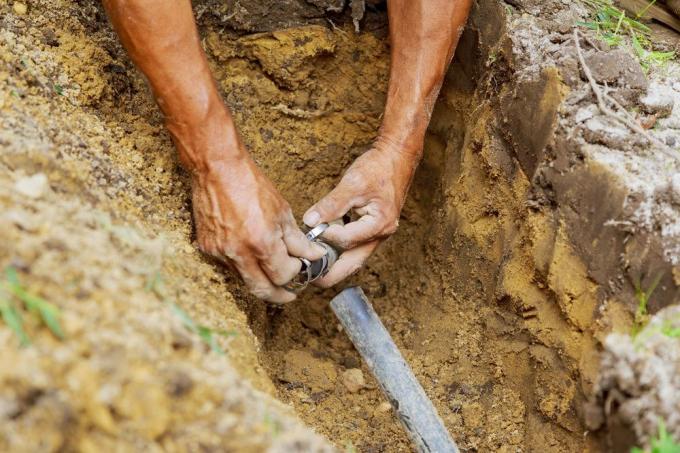
table of contents
- How does a Gardena drain valve work?
- Problems and their elimination
- The wrong installation
- Dirt in the irrigation water
- Roots in the valve
- Defective seals
- The wrong water pressure
- frequently asked Questions
An irrigation system brings convenience, but also dangers. Gardena garden irrigation systems have a drainage valve to prevent frost damage. But what to do if this is leaking?
In a nutshell
- Even the best Gardena drainage valve wears out at some point
- Foreign bodies between the seals often prevent them from closing completely
- If the water pressure is too low, the device will not trip
How does a Gardena drain valve work?
The helps to understand a possible source of error for a leaky drain valve Basic knowledge of how it works: The valve is in the idle state, i.e. without water-filled pipes opened. Even small amounts of water can flow off unhindered. The slide only closes via a spring mechanism once a specified pressure has been reached. With Gardena valves, this point is usually reached at around 0.2 bar. Now the irrigation system can do its job. If the water supply is stopped again, the pressure drops. When the threshold value is reached, the device opens and empties the residue.

Problems and their elimination
There are several problems that can cause the drain valve to leak. Depending on the cause, the necessary help differs:
The wrong installation
Usually the drain valve is built into a gravel pack. This way, escaping water can be absorbed and seep away. If the gravel is missing or too coarse, earth will eventually reach the drainage and can block the mechanism
Remedy:
- Expose the valve
- Remove the soil around 20 centimeters on all sides
- Line the group with filter fleece
- Bring in half of the washed gravel as a drainage pack
- Insert drainage device
- Cover the top of the device with gravel
- Wrap the fleece over the gravel packing on the top
- Apply soil
Dirt in the irrigation water
If the irrigation water in the irrigation system transports foreign substances such as dirt, sand or other particles, these can also get into the drainage device. Then it can happen that the drain valve closes, but the seals do not achieve a real seal. The water continues to run.
Remedy:
- Remove the drainage device
- Rinse lines thoroughly with fresh water
- Clean the device and check for damage to the seal
- If necessary, replace the seal
- Reinstall the drain valve properly
- Fit the irrigation pipes with a filter at the inlet

Note: The risk of dirt in the pipe is of course particularly high with rainwater. However, switching to drinking water runs counter to the ecological idea, so installing a filter on the irrigation system is clearly preferable.
Roots in the valve
The drainage device, along with the pipes for the entire system, will be buried in the ground. It is therefore obvious that roots sometimes grow onto the seal through the seepage packing. If, on the other hand, they continue to grow between the individual sealing rings, the valve can no longer close completely and it will leak.
Remedy:
- Expose drainage
- Remove roots from the fitting
- Check seals for damage and replace if necessary change
- Place drainage properly in gravel packing and cover
Tip: In the case of deeply rooted subsoil, you can also keep roots away with a root fleece. Before installing the gravel packing, place it in the hollow in the ground and then cover the septic tank with it.
Defective seals
Even properly installed valves wear out over time due to the recurring closing and opening processes. At some point the seals will wear out and no longer perform satisfactorily.
Remedy:
- Expose the drain valve
- Renew seals
- Alternatively, replace the entire device
- Carry out re-installation with restoration of the seepage packing

The wrong water pressure
In order to initiate the closing process of the valve, an overpressure in the water pipes is necessary. If this pressure is not reached, the water continues to run unhindered.
Remedy:
- Check lines for blockages and, if necessary, clean
- Water pressure raise
- z. B. Open the tap further
- z. B. Increase pump performance
Note: Damage can also be a cause of reduced water pressure. If the remedies mentioned do not help, you should check all components involved one after the other and repair them if necessary.
frequently asked Questions
Of course, you can do without drainage. However, you will then have to manually empty your drainage system in winter. You can do this, for example, by blowing out compressed air after you have removed an end cap.
It is true that every time the water pressure drops, there is an emptying. This means that after every watering, a certain amount of water seeps into the subsoil.
Above-ground irrigation systems often only remain in the flowerbed during the summer. Therefore, you can usually do without the device. If you dismantle it before winter, you will drain the pipes anyway.



